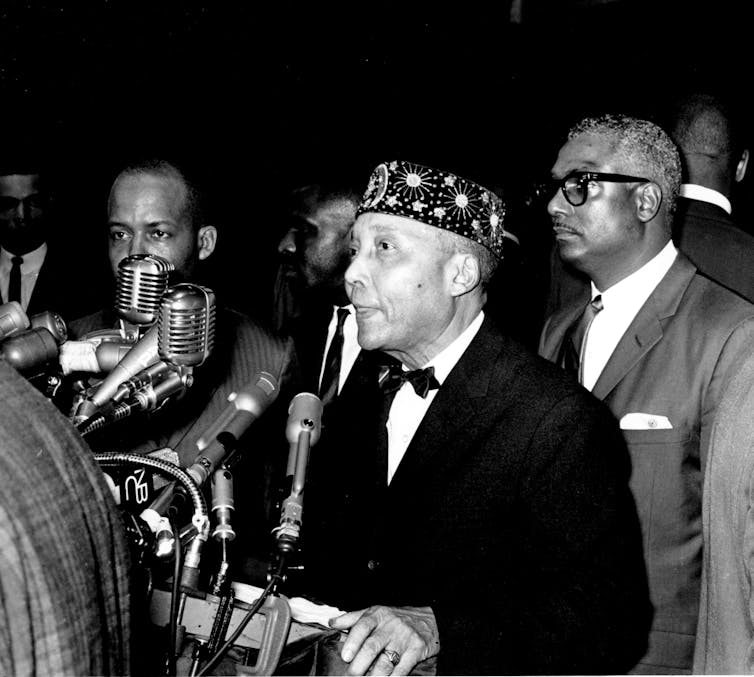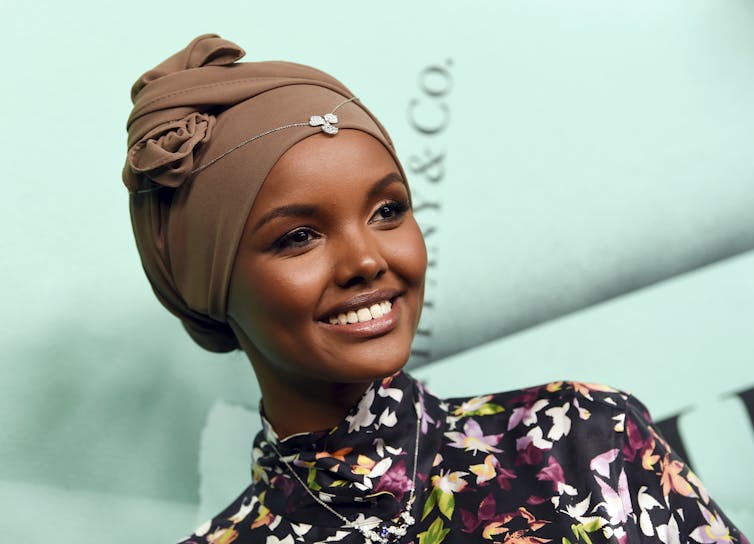The black Muslim female fashion trailblazers who came before model Halima Aden
- Written by Kayla Renée Wheeler, Assistant Professor of Area & Global Studies and Digital Studies, Grand Valley State University
Media reports have celebrated Halima Aden becoming the first woman to be featured in the Sports Illustrated annual swimsuit edition[1] wearing a hijab or a burkini. In the past, she has appeared on the covers of Allure, British Vogue and Glamour Magazine.
As a scholar[2] who studies black Muslim fashion, I often find that reporters covering Muslim women’s fashion seem to have the notion that Islam and fashion are incompatible.
This attitude ignores the influence black people have had on Muslim fashion going back at least eight decades[3].
Early Islam in the US
First, it’s important to understand the long history Muslims have in the United States.
According to the Pew Research Center[4], black Muslims account for one-fifth of all Muslims in the United States. Islam first came to the United States with enslaved Africans[5].
Their numbers were small, ranging from 30,000 to 40,000. However, as historian Sylviane Diouf[6] notes, enslaved African Muslims left a lasting impact on black American culture[7], especially in the Sea Islands and Lowcountry region, the coastal area[8] stretching from North Carolina to northern Florida.
The first Islamic text in the United States, the Bilali Document[9], was written by an enslaved African living on Sapelo Island named Bilali Muhammad in the 19th century. It includes rules about daily prayers and a list of beliefs of Muslims.
Another important text – perhaps the only known narrative[10] by an enslaved person in Arabic – was written by Omar ibn Said in 1831, who lived as a slave in North Carolina. In it, he recounts his life in Senegal, including his religious education. The autobiography also includes several Muslim prayers.
Clothing as identity
In the 20th century, black Americans were reintroduced to Islam through several people and organizations.
These included the Moorish Science Temple of America[11] and the Nation of Islam[12]. The Moorish Science Temple of America was founded by a Moorish American, Noble Drew Ali, in 1913 in Newark, New Jersey.
Drew Ali[13] taught his followers that they were not Negros or Ethiopians, rather they were Moors and that Islam was their true religion. According to Drew Ali, Moors are descendants of the ancient Moabites who founded Mecca, one of the most important cities in Islam.
W.D. Fard Muhammad, who founded what would become known as the Nation of Islam in 1930 in Detroit, Michigan, also taught his followers that they had forgotten their true identity as Asiatic Muslims[14] and members of the lost tribe of Shabazz. The term Asiatic[15] referred to black people and other people of color.
Clothing played a central role in constructing a unique black Muslim identity[16]. Black Muslim women used their dress to challenge American beauty standards[17], which typically holds thin young white women as the ideal beauty. Their dress practices also challenged beliefs that Islam was only an Arab religion[18] by encouraging members to develop their own local dress practices.
In the Moorish Science Temple of America, male members wore fezzes or turbans[19] and women wore turbans[20] often paired with long shift dresses as part of their everyday wear.
Men in the Nation of Islam dressed in tailored suits[21] and bow ties or ties. Women donned a Muslim Girls Training uniform[22]. The Muslim Girls Training[23] included lessons for women and girls on the rules and beliefs of the Nation of Islam as well as how to cook, clean, raise children and practice self-defense. The uniform[24] included a high-neck tunic that came down to the thigh. It was paired with either loose-fitting pants or a skirt that came to the ankles.
Black Muslims
In my forthcoming book, I argue that Nation of Islam and the Imam W.D. Mohammed community have played an important role in developing the modest fashion industry in the United States. Imam W.D. Mohammed[25] took over the leadership of Nation of Islam in 1975, following the death of his father Elijah Muhammad, who had succeeded the founder W.D. Fard Muhammad.
 Elijah Muhammad, leader of the Nation of Islam, addresses the concluding session of the annual convention in Chicago in 1966.
W.D. Fard Muhammad[26]
Elijah Muhammad, leader of the Nation of Islam, addresses the concluding session of the annual convention in Chicago in 1966.
W.D. Fard Muhammad[26]
These organizations and their members have organized fashion shows and operated clothing stores centered on Islamic modesty since the 1960s[27]. The models were usually volunteers from the local community. Elijah Muhammad[28] discouraged female members from embracing the fashion trends of the day.
The fashion shows were a means of highlighting the creative ways Nation of Islam women could dress modestly and maintain the unique aesthetic, while still looking beautiful. They featured diverse head coverings such as berets and fezzes, color-block outfits and different takes on the classic Muslim Girls Training tunic[29].
Imam W.D. Mohammed and his members would continue to encourage women’s fashion ventures[30]. They incorporated Afrocentric inspired designs and clothing[31], like the dashiki and kente cloth.
For a decade, starting in the 1960s, when the oldest daughter of Elijah Muhammad, Ethel Muhammad Sharrieff[32] led the Muslim Girl’s Training, clothing became a way of building a self-sustaining black Muslim community.
A clothing factory[33] she managed produced the official Muslim Girl’s Training uniform. Members were encouraged to buy the uniform from the factory. Temple #2 clothing, a store in Chicago, Illinois, sold a wide range of products including shoes, lingerie and jewelry.
Fashion shows
This May, I attended the Sealed Nectar Fashion Show[34], an annual fashion show hosted by the Atlanta Masjid of al-Islam in Atlanta, Georgia. It is one of the longest-running Muslim fashion shows in the United States, with 2019 marking its 33rd anniversary.
The fashion show was founded in 1986 by Amira Wazeer[35], an Atlanta-based designer, as a means of celebrating beauty and modesty. This year’s theme, “World Traveler[36],” featured six black Muslim women designers[37] from the United States, Tanzania and Kenya.
More recent ones include in cities such as Washington D.C., Houston[38] and an upcoming one in Philadelphia[39].
A Muslim women’s fashion show in Washington D.C.The fashion shows and bazaars highlight black women’s creativity and diverse definitions of Islamic modesty. This includes different styles of wrapping head scarves – turbans and buns[40] that leave the neck and ears exposed to show off jewelry – as well as multiple clothes layering techniques[41], like wearing a pair of skinny pants under a short dress.
Black Muslim models
 Halima Aden at the Tiffany & Co. 2018 Blue Book Collection.
Photo by Evan Agostini/Invision/AP[42]
Halima Aden at the Tiffany & Co. 2018 Blue Book Collection.
Photo by Evan Agostini/Invision/AP[42]
What Aden has been able to accomplish in three years is certainly worth celebrating. She has opened the doors for other hijabi models like Ikram Omar Abdi, who was featured on the cover of Vogue Arabia[43] along with Aden and another Muslim model, Amina Adan[44].
However, in my view, it is important to place Halima Aden within the larger history of black Muslim fashion in the United States. Unless we do that, there is a risk of erasing the black Muslim fashion trailblazers who came before her and made her rise possible.
References
- ^ Sports Illustrated annual swimsuit edition (www.nytimes.com)
- ^ scholar (scholar.google.com)
- ^ eight decades (nyupress.org)
- ^ Pew Research Center (www.pewresearch.org)
- ^ enslaved Africans (theconversation.com)
- ^ Sylviane Diouf (www.sylvianediouf.com)
- ^ lasting impact on black American culture (nyupress.org)
- ^ coastal area (gullahgeecheenation.com)
- ^ Bilali Document (www.jstor.org)
- ^ narrative (www.loc.gov)
- ^ Moorish Science Temple of America (nyupress.org)
- ^ Nation of Islam (nyupress.org)
- ^ Drew Ali (global.oup.com)
- ^ Asiatic Muslims (academic.oup.com)
- ^ Asiatic (www.tandfonline.com)
- ^ unique black Muslim identity (nyupress.org)
- ^ challenge American beauty standards (www.uncpress.org)
- ^ challenged beliefs that Islam was only an Arab religion (nyupress.org)
- ^ fezzes or turbans (www.chicagoreader.com)
- ^ turbans (www.chicagoreader.com)
- ^ tailored suits (www.gordonparksfoundation.org)
- ^ uniform (www.gordonparksfoundation.org)
- ^ Muslim Girls Training (www.uncpress.org)
- ^ uniform (www.gordonparksfoundation.org)
- ^ Imam W.D. Mohammed (www.pbs.org)
- ^ W.D. Fard Muhammad (www.apimages.com)
- ^ 1960s (nyupress.org)
- ^ Elijah Muhammad (books.google.com)
- ^ Muslim Girls Training tunic (www.finalcall.com)
- ^ encourage women’s fashion ventures (nyupress.org)
- ^ Afrocentric inspired designs and clothing (hagarlives.blogspot.com)
- ^ Ethel Muhammad Sharrieff (www.chicagotribune.com)
- ^ factory (books.google.com)
- ^ Sealed Nectar Fashion Show (sealednectarfashionshow.com)
- ^ Amira Wazeer (hagarlives.blogspot.com)
- ^ World Traveler (www.youtube.com)
- ^ designers (sealednectarfashionshow.com)
- ^ Houston (www.muslimatcollective.com)
- ^ Philadelphia (ummfashionshow.com)
- ^ turbans and buns (www.youtube.com)
- ^ layering techniques (www.youtube.com)
- ^ Photo by Evan Agostini/Invision/AP (www.apimages.com)
- ^ cover of Vogue Arabia (en.vogue.me)
- ^ Amina Adan (en.vogue.me)
Authors: Kayla Renée Wheeler, Assistant Professor of Area & Global Studies and Digital Studies, Grand Valley State University

